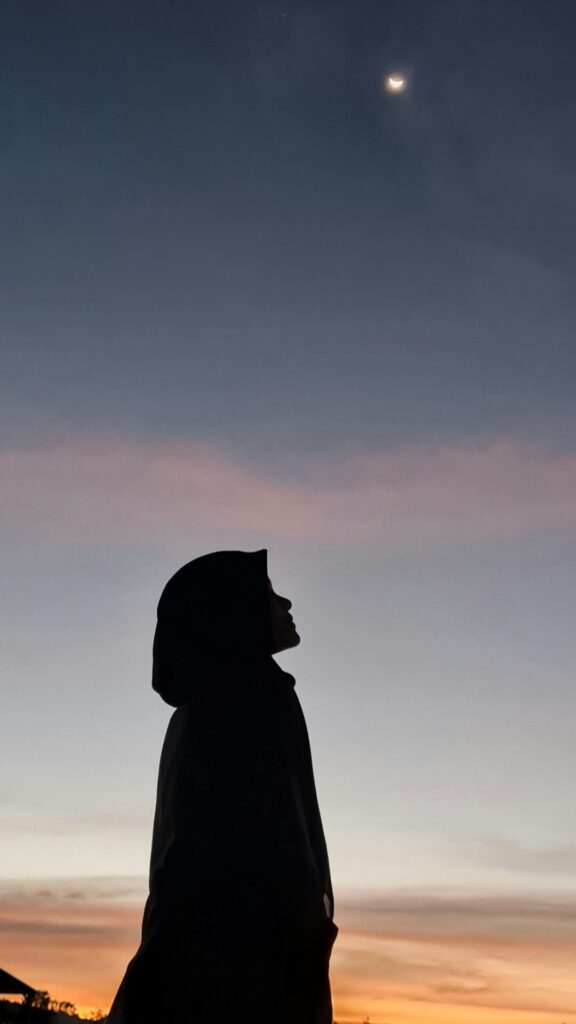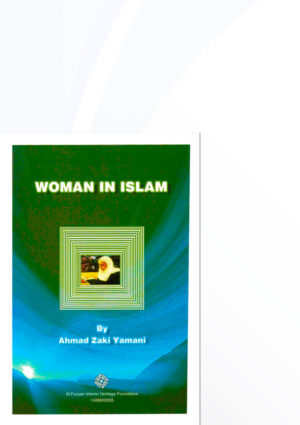Aḥmad Zaki Yamani

In the pre-Islamic period, women were in a very lowly status in Arabia. An Arab man would look at a woman as a source of shame and humiliation. If a father was given the news of the birth of a girl, he would be extremely distressed, wondering whether he should have the humble option of keeping her or that of burying her alive. God describes this in the Qurʾan: “When any of them is given the happy news of the birth of a girl, his face darkens and he is filled with gloom. He tries to avoid all people on account of the [allegedly] bad news he has received, [debating within himself:] shall he keep the child despite the shame he feels, or shall he bug it in the dust? Evil indeed is their judgement” (Q 16: 58-59)
When the Prophet began to receive his message, he concentrated during the Makkan period that preceded his immigration to Madinah on advocating God's oneness in an idolatrous society, and called for equality in a social environment that stressed distinction of tribe, family and ancestry. This period did not establish definitive rulings that could establish women's legal competence or their social status vis-à-vis men. Nevertheless, women took full part in advocating the new message, withstanding much pressure exerted on them by the unbelievers. Khadijah, the Prophet's wife, was the first to believe in Islam, while Sumayyah bint Khayyat, ʿAmmar's mother, was the first martyr in Islamic history. Muslim women accompanied Muslim men on their immigration to Abyssinia. Two women from the Ansar were among those who pledged loyalty to the Prophet at alʿAqabah, which was the pledge that heralded the immigration of the Prophet to Madinah.
Thus began the Madinan period which gave birth to the first Muslim society and state. This ushered the first legal and social revolution which gave women a status that was unprecedented in Arabia. They became equal to men and full partners in social life. It was only belief in God and total obedience to His orders that enabled the Quraysh men who immigrated to Madinah to accept the new status of women. What made it easier for such a change to be accomplished was that the Ansar women in Madinah enjoyed a more open relationship with their husbands which allowed them to speak up expressing their own views. Women from the Quraysh who immigrated to Madinah began to do likewise.
We will see later some examples which should have served as a platform to deduce rulings that are more suitable for our times which are fundamentally different from the economic, cultural and social conditions that prevailed in Madinah at the time. However, the opposite has happened in some Muslim countries, where restrictions based on social and tribal traditions have been imposed and attributed to Islamic law, when in fact they have nothing to do with it. Unfortunately, this state of affairs could easily lead to an explosion which may take us further away from Islamic standards and principles. Nothing can protect us from the tide of globalization and its various means of influence, such as satellite television and the Internet, except a proper implementation of Islam, based on clear understanding that discards the concepts inherited from the period of intellectual stagnation which the Muslim world had gone through.
The Madinan period and subsequent generations that witnessed the progress of Islam into a vast area did not experience any form of prevention of women's participation with men. All that Islam prohibited was 'solitary mixing' in which one man is alone with one woman, who is a stranger to him, in a place where they are not seen by anyone. The Prophet made it clear that no man should visit a woman whose husband is absent, saying: “As from today, let no man enter the home of a woman whose husband is away, unless he is accompanied by one or two others” [Related by Muslim and Aḥmad]. When two men or more visit such a woman, enquiring after her, their action conforms to the Islamic standards of propriety, just like women's frequenting mosques, attendance at Eid prayers which are normally offered outside the city, and listening to the Prophet's sermons. In fact, during the Prophet's lifetime, certain women left their doors open to receive guests, and they often had visitors from among the Prophet's companions. When Fatimah bint Qays sought the Prophet's permission to spend her waiting period after her husband's death in Umm Sharik's home, he described Umm Sharik as a 'woman with numerous guests'. [Related by Muslim] Women used to go to the market place for their shopping. This even applied to the Prophet's wives after they were ordered to remain secluded. In support of this we may cite the Ḥadith which mentions that ʿUmar objected to Sawdah, the Prophet's wife, when he saw her on her way to the market. When she returned, she told the Prophet who said to her: 'God has permitted you to go out to attend to your needs” [Related by al-Bukhari and Muslim]. If this applied to the Prophet's wives who have been ordered to speak to men only from behind a screen, then it applies in a greater measure to ordinary Muslim women who are not issued with such an order.
Women's role in Madinan society reached its zenith when ʿUmar ibn al-Khattab, the second of the four rightly-guided Caliphs, appointed al-Shifaʾ bint ʿAbdullah of Makhzum as Muhtasib, or Superintendent, of the market. Her post carried judicial and executive responsibilities. It represents a practical authority to enjoin what is right and forbid what is wrong. In relation to our modern standards, the market at the time was the centre of all business activity. How could a woman be in control of such important activity if she were to remain indoors?
ʿUmar appointed Samraʾ bint Nuhayk of the Asad clan in the same post in Makkah, and he gave her a whip to punish anyone who cheated or gave short measure,1 which confirms what I have already said about the post combining judicial and executive responsibilities.
Women were an integral part of Islamic society in Madinah during the Prophet's lifetime, taking part alongside men in all aspects of social life. When they met, they greeted each other. Al-Bukhari includes in his Saḥiḥ a chapter under the heading, 'Men's greeting of women, and women's greeting of men', in which he relates a number of Ḥadiths which refute any argument that they should not greet each other when they meet. Indeed there are numerous Ḥadiths on this topic.
Women also attended general meetings in the Prophet's mosque in Madinah. When an announcement was made for such a meeting, women hurried to the mosque to take part alongside men in such a meeting. An example of this is the case of Fatimah bint Qays who responded to such a call as mentioned in an authentic Ḥadith related by Muslim in his Saḥiḥ anthology.
Women could open a nursing surgery to look after patients. Rufaydah al-Aslamiyyah started such a surgery in a tent that belonged to the Ghifar tribe, erected close to the mosque, where she looked after those injured in battle. This is stated in a Ḥadith related by al-Bukhari in al-Adab al-Mufrad2.
The mosque was a place of worship for both men and women. Indeed, women practised the iʿtikaf sunnah in the same way as men, which meant spending several nights in the mosque devoting one's time completely to worship. The mosque was also an educational institute in which women took full part together with men. The Ḥadiths confirming this are too numerous to cite, and many of these are included in the two Saḥiḥ anthologies by al-Bukhari and Muslim, which means that they are authentic. Likewise, the mosque was a social club in which different types of leisure activities took place, such as folk dancing by an Abyssinian delegation. This was attended by ʿAʾishah, the Prophet's wife, after his wives were commanded not to speak to people except from behind a screen. The Prophet put his robe in front of her so that she was not seen. This is mentioned by Ibn Hajar in his commentary on al-Bukhari's Saḥiḥ under the heading 'Refuting the view prohibiting play in the mosque.3 '
During the time of the Prophet, women's business activity included agriculture and trade. We have many Ḥadiths that speak of this, such as the one in Muslim's Saḥiḥ which mentions Umm Mubashshir who had a date-palm farm. Another Ḥadith mentions Jabir ibn ʿAbdullah's maternal aunt, who wanted to go out to her farm to supervise the cutting of her date fruit. Jabir objected to her going out because she was in her waiting period, having recently become a widow. She put the matter to the Prophet who said to her: “Yes, you can cut your date fruit. You may also give something to charity or do something good” [Related by Muslim, Abū Dawud and Aḥmad].
Women were not hidden behind veils, except for those who used to wear it as a habit, but these were few and far between. Indeed, the veil which covers the face is prohibited to wear during prayer and when the woman is in the state of consecration, or ihram, during the pilgrimage or the umrah [i. e. mini-pilgrimage]. A woman who wanted to get married might even adorn herself to appeal to would-be suitors. The case of Subayʿah bint al-Harith who adorned herself shortly after she had finished her waiting period is one in point. Abū al-Sanabil reproached her claiming that it was too early for her to do so. In her case, the waiting period finished early because she gave birth within a few days of her husband's death. Hence, she did not have to wait the fullperiod of four months and ten days. Abū al-Sanabil did not realize the difference and made his objection to her. When she complained to the Prophet he approved her action.4 Abū al-Sanabil proposed to her but she refused him. She then received two proposals one from a middle-aged man and the other from a young man. She chose the latter.5
One of the more important roles women played during the time of the Prophet was joining him on military expeditions. Fighting is not one of women's duties, but they were allowed to join such expeditions as volunteers. However, in a defensive war to repel attack on Muslim land, women are duty bound to join.
In military conflicts, women played a supportive role, tending the injured fighters, providing soldiers with water to drink and doing similar tasks. However, women could take part in the actual fighting when the need arose. Again we have many examples, but the best is the case of Nasibah bint Kaʿb, an Ansari woman who took part in battles and events at Uhud, al-Hudaybiyah, Khaybar, Hunayn, the compensatory umrah and the Battle of Yamamah. She actually fought in Uhud. ʿUmar quotes the Prophet as saying: 'Whenever I turned right or left during the Battle of Uhud, I saw her fighting to defend me. “6 During that battle, she was with Umm Ayman and Umm Sulaym, the three of them doing their support duty, but when they realized that the unbelievers were winning, they abandoned tending the injured, put down their pails, picked up swords from those who were killed and took part in the actual fighting, defending the Prophet. Al-Wagidi mentions that Nasibah “fought in the Battle of Uhud and suffered 12 wounds. She nursed a wound in her neck for one whole year until it healed. “7 During Abū Bakr's reign, she joined one of the armies fighting the apostates, and she took part in the actual fighting until Musaylamah, the liar leading the rebellion, was killed. When she returned to Madinah, she was nursing ten wounds she received in that battle: some were stabs and some were hits with swords.8
Ibn Saʿd also reports that Umm Sulayt participated in the Battles of Khaybar and Hunayn. Muslim also relates in his Saḥiḥ anthology on Anas's authority that “Umm Sulaym carried a dagger during the Battle of Hunayn and said, “If any unbeliever draws near to me, I will kill him. “
One of the heroines of the Battle of Uhud was Umm Ayman, the Prophet's nurse in his childhood. She saw an unbeliever aiming an arrow at him and she jumped to shield the Prophet. The arrow hit her in her shoulder, close to her neck.9 In the Battle of Khaybar, Umayyah bint Qays of Ghifar fought hard against the Jews, and the Prophet gave her a necklace to wear, like we today award medals to distinguished fighters.
Women continued to take part in actual fighting in subsequent battles which took place after the Prophet's time. Asmaʾ bint Yazid ibn al-Sakan killed 9 Byzantine soldiers in the Battle of al-Yarmūk, using the pole of her tent. Umm Musa of the Lakhm tribe, Musa ibn Nusayr's mother, took part in the same battle and killed an enemy soldier, taking his equipment as booty. 10
Umm Haram requested the Prophet to pray that she would join the Muslim army which was to travel by sea to fight for God's cause. He did and she joined that army during ʿUthman's reign. She died as a martyr and was buried in Larnaka, in Cyprus. 11
Examples of heroic participation in fighting by Muslim women are too numerous to cite. Some, like Asmaʾ bint Abi Bakr, Khawlah bint al-Anwar and Umm Hakim, ʿIkrimah ibn Abi Jahl's wife, distinguished themselves with bravery and fighting prowess to a degree that favourably compares with the best male fighters.
What I would like to stress here is that while armed fighting is not required of women as a duty, as it is required of men, it is permissible. Hence, there is no religious restriction to prevent Muslim women today from being recruited as soldiers in land forces, or the navy or air force, provided, however, that all Islamic requirements are observed. It should be remembered that such requirements ensure that women are well protected and respected. They do not detract from women's position in any way.
The Prophet's female companions who reported his Ḥadiths are too well known and too numerous to mention by name or scholarly position. Other companions of the Prophet and their successors used to go to them and learn from them. Foremost among these were the Prophet's own wives.
During the Prophet's lifetime, Muslim women took part in politics, such as the pledge of loyalty, the immigration, participation in consultation and giving advice. Some of those who try to detract from the position of women in Islam maintain that the pledge of loyalty given by women is mainly concerned by the pledge not to commit theft or adultery. They conveniently overlook the other terms of the pledge as detailed in the Qurʾan: “Prophet, when believing women come to you to pledge their allegiance to you, confirming that they would not associate parteners with God, and would not steal, commit adultery, kill their children, perpetrate a falsehood between their hands and feet, and never disobey you in anything that is right, then accept their pledge of allegiance, and pray to God to forgive them” (Q 60: 12) They also claim that the Prophet's immigration was not a political step, when it was indeed a major political move required of all Muslims, men and women, except those who were so oppressed that they were physically unable to immigrate. In citing evidence of women's participation in politics we need go no further than the incident when some of the Prophet's companions were slow to carry out his orders and release themselves from the state of consecration, or ihram, after he concluded the al-Hudaybiyah peace treaty with the unbelievers. It was his wife, Umm Salamah, who gave the Prophet sound advice that ensured prompt obedience by all his companions. In doing so, she demonstrated a profound sense of understanding the problem which was clearly a political one.
These are just some examples of women's full participation in all fields of life, side by side with men, during the Prophet's lifetime. It is easy to cite numerous other ones that confirm this conclusion, but we hope that the examples we have given present the true Islamic picture which is at variance with what prevails in some Muslim countries as also with what some scholars maintain.
| Source note: This was published in: Woman in Islam_ English version, 2005, Al-Furqan Islamic Heritage Foundation, London, UK, p 27-38. Please note that some of the images used in this online version of this article might not be part of the published version of this article within the respective book. |


